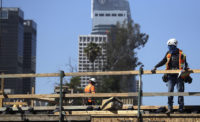Despite California’s strict government interventions in response to the COVID-19 pandemic, the state’s economy is poised for post-pandemic growth at a faster rate than the rest of the U.S, says a new report from the University of California-Los Angeles Anderson School of Management.
But contractors and other employers will have to wade through increasing workplace requirements from various government entities, including Cal/OSHA and others at the state and local level.
“Since the pandemic-induced recession began last March, we have said that the course of the pandemic, and the public health policy response to it, is critical to the economic forecast,” says the UCLA Anderson Forecast, authored by report director Jerry Nickelsburg, and economist Leila Bengali.
The report analyzes the future effects of California’s more restrictive non-pharmaceutical interventions (NPI) on the state’s economy.
While the state has higher unemployment than in the U.S. overall, California is expected to grow faster than the rest of the country once restrictions are lifted, says the report, which assumes a large portion of the population will receive the vaccine by this summer. Technology sectors, residential construction and logistics are expected to lead California’s recovery.
“In spite of the recession, the continued demand for a limited housing stock coupled with low interest rates lead to a forecast of a relatively rapid return of homebuilding,” says the report, which expects 123,000 net new units in 2021, up 16.2% from 2020, and 132,000 units in 2023. “Needless to say, this level of home building means that the prospect for the private sector building out of the housing affordability problem over the next three years is nil.”
Overlapping Regulations
In the meantime, some California contractors are scrambling to meet and understand Cal/OSHA’s emergency regulations that went into effect on Nov. 30 at the same time they are preparing for AB 685’s COVID-19 Notification Requirements, effective Jan. 1. AB 685 compels employers to provide notice to employees and others of worksite “potential exposure to COVID-19.”
Cal/OSHA’s emergency standards, adopted by its standards board last month, added employer requirements to create written prevention programs, testing and reporting components on top of current local mandates that vary across cities and counties, and apply to most workers not covered by Cal/OSHA’s Aerosol Transmissible Diseases standard.
The Cal/OSHA standard says employers must exclude from the workplace employees who are COVID-19 positive and employees with workplace exposure, both with separate, set minimum timelines, and return to work criteria.
Under the standard, employers are required to “maintain an employee’s earnings, seniority, and all other employee rights and benefits, including the employee’s right to their former job status, as if the employee had not been removed from their job.” Employers may use employer-provided sick leave and may consider other public sources of benefit payments “in determining how to maintain earnings, rights and benefits, where permitted by law and when not covered by workers compensation.”
On a United Contractors webinar on Dec. 9, attendees expressed concern about the regulation’s requirement that employers provide “exclusion pay” to workers who test positive or are exposed to the virus through their workplace. Mark Breslin, CEO of the large Bay Area contractor group, says it is concerned with the exclusion pay clause’s unlimited duration and unpredictable cost impacts, and will express concerns at Cal/OSHA’s upcoming stakeholder meeting.
Rachel Conn, a Nixon Peabody LLP associate in San Francisco who specializes in labor and employment law, says the Cal/OSHA regulation’s definition of “exposed workplace” raises questions, since it is not limited to people actually exposed but is broader to include workplace areas and locations where the COVID positive worker was – but also to workers present but not necessarily exposed through close contact.
The Centers for Disease Control defines close contact as someone who was within 6 ft of an infected person for at least 15 minutes starting from two days before illness onset (for asymptomatic clients, two days prior to positive test) until the time the patient is isolated. Cal/OSHA's exposed workplace standard does not include buildings or facilities not entered by a COVID-19 case.
Conn says "an exposed workplace could mean, for example, the whole working area of a construction site could potentially be an exposed workplace if those were areas that the COVID case was present, but let’s say nobody comes in close contact. Those count, even though no one came into close contact with that person,” she says.
Conn sees potential overlap between the notifications requirements from Cal/OSHA and in AB 685. This means contractors will need to meet both Cal/OSHA and AB 685 communication requirements to employees about workplace exposure. While the requirements are similar, there are differences.
Cal/OSHA does not require notifications to be written. Its notification requirement says employers must alert employees and others present in the workplace of "potential COVID-19 exposure" - anyone who may have come in close contact with the positive person - within one business day. Meanwhile, AB 685 requires communication to be sent to anyone who was on the worksite where a COVID-19 positive was present, even if they were not necessarily exposed.
Dwayne P. McKenzie, a partner in Cox, Castle & Nicholson’s Los Angeles office, says a primary concern about the Cal/OSHA emergency standards stems from the extent to which there are no limits on the earnings amount employers are required to maintain for COVD-19 cases and employees with COVID-19 exposure.
“But those concerns may be mitigated as a practical matter from what we have seen about the typical duration of the illness and the 14-day period that employees with COVID-19 exposure would be excluded from the workplace,” says McKenzie, who notes that costs for higher wage employees could be higher than the limits already set by other COVID-19 sick leave requirements.
McKenzie says if employers knew the same conditions would continue next year and perhaps after, there would be more pressure to challenge the standards. But a vaccine marks the “light at the end of the tunnel” that may cause some who might consider challenging the regulations to instead move through the months ahead, she says.
“I think the question will be whether a particular group of employers or industry see enough potential liability that they want to challenge it as in excess of Cal/OSHA’s authority,” adds Dwayne P. McKenzie, a Los Angeles partner in Cox, Castle & Nicholson. “We’re in an interesting period as to that potential liability, because on one hand we are seeing the highest number of cases that we have seen, while on the other hand the hope is that with the roll-out of vaccines will allow us to get the virus under control next year.”
Test, Test, Test
Scott Brauninger, chief operating officer at San Francisco-based Build Group Inc., says the Cal/OSHA standard is flawed and should make exception for employers who have testing systems that comply with CDC requirements in place. Since July, Build Group has offered 20,000 free tests to all employees and subcontractors, with testing done at least once a week at every jobsite.
“Almost all of our positive test results occur before symptoms; like 99%,” says Brauninger. “Once a testing program is implemented on projects, we have seen positivity go to near zero after just two weeks.”
He says testing allows contractors and clients to maintain continuous operations. “Testing also provides accurate data that will prevent successful work comp over actions in the future that may be uninsured,” he says. “This is going to be huge money and we don’t understand how employers aren’t realizing that testing is the only way to have the data they will need to fight these cases.”
McKenzie says the best thing contractors can do is to continue complying with existing safeguards, especially physical distancing to prevent employees from COVID-19 exposure.
“If employers are able to maintain physical distances by employees, they can limit the number of employees with COVID-19 exposure who would need to be excluded from the workplace and be entitled to compensation under the Emergency Standard,” says McKenzie.
Employers should also implement other COVID-19 sick leave requirements (like the benefits under the Federal Families First Coronavirus Response Act, California Labor Code, workers compensation, etc.) so that the amounts paid to employees under existing obligations will also satisfy Cal OSHA’s emergency standard.
R.D. Olson Construction is focusing on jobsite density, social distancing, masks, temperature checks and other safety protocols. The process to implement these new procedures to comply with regulations has been “relatively smooth," the contractor says.
“Appropriate distancing is one of our primary focuses,” says Bill Wilhelm, firm president. “We must be aware of how many workers are on scaffolding and if they are the appropriate distance apart, and that manlift elevators aren’t putting people in too close of proximity, for example.”
Dan Rogers, president of Blach Construction, says the regulations have been fairly straightforward. “That said, regulations coming from the Centers for Disease Control, the state and the counties all differ. It would be preferable if at least the state and counties were more unified in their directives.”
The Tunnel’s End
Wilhelm is concerned that community spread could cause a reduction in its workforce due to positive testing, although R.D. Olson has not seen higher rates of absenteeism due to the pandemic, even while noting ongoing shortage of qualified crafts workers in general.
R.D. Olson revenue over the past eight months has fallen “ in a global sense” as projects were cancelled or delayed because of permits, banking regulations and overall costs. “Regulations as well as the increasing COVID-19 numbers can, and quite possibly will, have an impact on construction progress, material availability and manpower," says Wilhelm. "If the COVID-19 numbers continue to rise as they are currently, the imbalance of supply/demand when it comes to materials will create challenges.”
But he adds that R.D. Olson's outlook is promising and, while anticipating challenges in next year’s first and second quarters, he is optimistic for the third quarter and beyond thanks to available vaccines.
“It all starts at home base for every contractor,” Wilhelm says. “If we can all come together to focus on being more responsible and seeing each other as human, we will be stronger for it and see the other side of this challenging time sooner than later.”
Meanwhile, Blach’s projects have continued despite the pandemic, and while complying with PPE and sanitation protocol has increased the cost of doing business, gained efficiencies have balanced the costs, Rogers says.
Blach has seen significant schedule gains on most education projects and its Gateway at Millbrae Station BART, transportation-oriented development. But some workplace projects have hit “pause” as clients determine the future office space while hospitality projects are finding difficulty finding financing.






Post a comment to this article
Report Abusive Comment